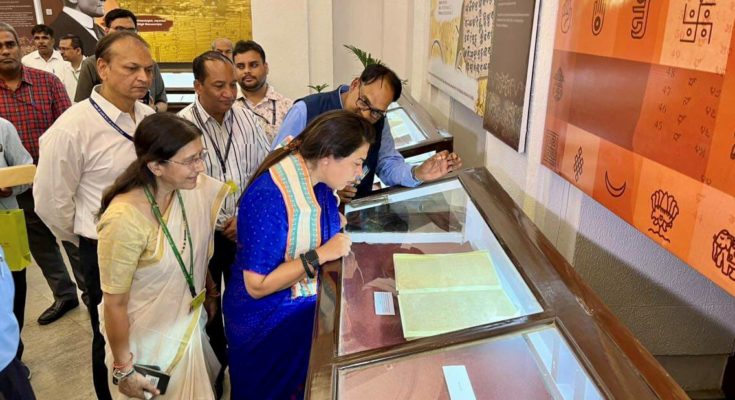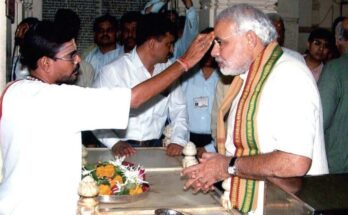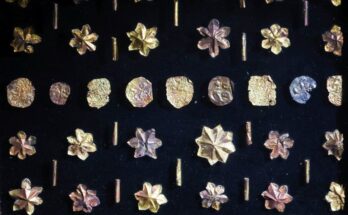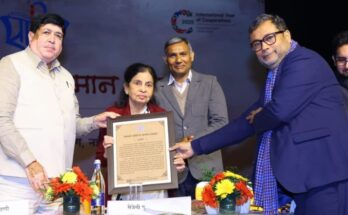International Archives Day: Minister of State for Culture, Smt. Meenakashi Lekhi inaugurated an exhibition under the Azadi Ka Amrit Mahotsav (AKAM) titled “Hamari Bhasha, Hamari Virasat” today to celebrate 75th International Archives Day at National Archives of India, New Delhi.
This exhibition is an endeavour to commemorate the treasured heritage of India\’s linguistic diversity as a Nation: “राष्ट्र एक भाषा अनेक” India is blessed with extraordinary language diversity. According to an estimate out of 7,111 languages spoken globally, about 788 languages are spoken in India alone. India is thus one of the four most linguistically diversified countries in the world, along with Papua New Guinea, Indonesia, and Nigeria.
On the occasion Minister of State for Culture, Mrs. Meenakashi Lekhi said , “On the occasion of International Archives Day, National Archives of India has made available the Gilgit Manuscripts written between the 5″ -6” centuries CE, which is the oldest surviving manuscript collection in India. She also said that the birch bark folios documents written on pieces of inner layer of the bark of birch trees were found in Kashmir region and contain both canonical and non-canonical Jain and Buddhist works that throw light on the evolution of many religious-philosophical literature. She also added that Younger generation must get introduced to Gilgit Manuscripts.
She also said, “ I also congratulate the National Archives of India for making approximately more than 72,000 manuscripts available at the premises and through the process of digitization it will reach all over the world, which will particularly help our younger generation to get introduced to these manuscripts.”
The Exhibition presents a selection of original manuscripts drawn from the annals of the archival repository (such as the birch-bark Gilgit manuscripts, Tattvartha Sutra, Ramayana, and Srimad Bhagwad Gita, among others), official files of the government, proscribed literature under the clonial regime, private manuscripts of eminent personalities, as well as from the rich collection of rare books held in the NAI Library.
The Exhibition includes among the most ancient in the world —The Gilgit Manuscripts were discovered in three stages in the Naupur village (Gilgit region), and first announced by archaeologist Sir “Aurel Stein in the year 1931. Not only this, the exhibition further sheds light on the vast corpus of archival records pertaining to variegated languages spoken across the length and breadth of the nation.
As we are celebrating 75 years of our independence, through this exhibition the National Archives of India pay tribute to the linguistic diversity of our nation. The languages of India have from the earliest times been a subject of interest to not only those who spoke them, but to foreigners as well, who conducted a serious study of Indian languages (for instance, the Linguistic Survey of India). The exhibition will remain open for public viewing till 08 July 2023 from 10:00 am to 5:00 pm on each day including Saturday, Sunday and National Holidays.
The National Archives of India was established on 11 March 1891 at Kolkata (Calcutta) as the Imperial Record Department. Following the transfer of the capital from Calcutta to Delhi in 1911, the present building of the National Archives of India was constructed in 1926 which was designed by Sir Edwin Lutyens. The transfer of all records from Calcutta to New Delhi was completed in 1937.The National Archives of India is also the nodal agency for the implementation of the Public Records Act, 1993 and Public Record Rules, 1997.
National Archives of India has at present in its repositories a vast collection of records, which include files. volumes, maps, bills assented to by the President of India, treaties, rare manuscripts, oriental records, private papers, cartographic records, important collection of Gazettes and Gazetteers, Census records, assembly and parliament debates, proscribed literature, travel accounts, etc. A major chunk of Oriental records are in Sanskrit, Persian, Arabic, etc.




